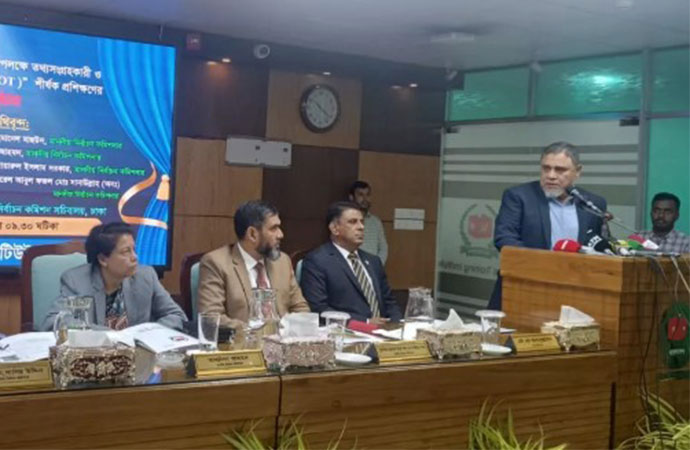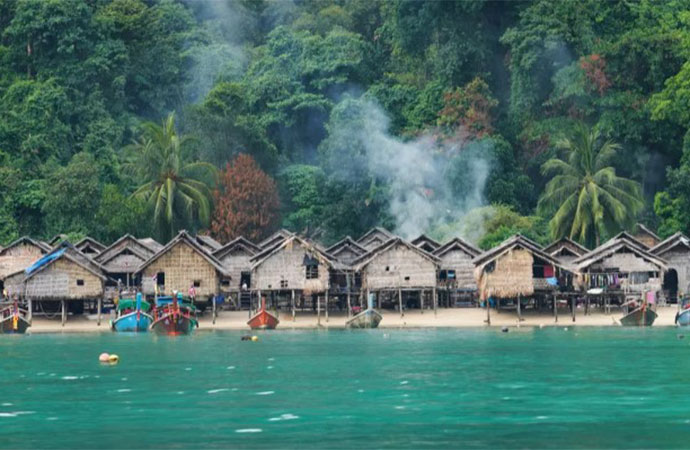Reportage

In the Araihazar upazila of Narayanganj, just outside the perimeter of capital Dhaka, a Special Economic Zone for Japanese companies is being developed by the government of Bangladesh in partnership with the Japan International Cooperation Agency (JICA). Japan is eyeing to raise $1 billion investment from around 100 companies in the economic zone, according to Naoki Ito, Ambassador of Japan to Bangladesh.
These Japanese companies - including Japanese manufacturers of cars, motorcycles, mobile phones, electronic equipment and motor parts, such as Toyota, Mitsubishi, Sumitomo and Sujit Limited - seek competitive labour costs and supply-chain diversification. The investment is expected to create around 1 lakh (100,000) jobs.
The Tk 2,700-crore (around $300 million) economic zone is currently expected to begin operations in late 2022. It will be developed on 1,000 acres of land, 32 kilometres from the centre of Dhaka. Bangladesh has 30% share and Japan has 70% share of the economic zone, noted Yusuf Harun, Executive Chairman of Bangladesh Economic Zones Authority (BEZA).
Sumitomo Corporation, one of Japan's leading business houses with a 300-year history, has been appointed as the land developer of the zone. In recent years, Sumitomo has taken up such economic zones/hi-tech park projects in a number of countries, mostly in other emerging Asian economies like Vietnam and the Philippines. The company signed an agreement with BEZA in 2019.
Ambassador Ito noted that Japanese investors plan to develop economic zones in Chattogram and Cox's Bazar when the Araihazar economic zone becomes successful.
Around 321 Japanese companies operate in Bangladesh at present-a jump in number from the 83 companies operating in 2010. At an investment summit held in October 2021, Shahabuddin Ahmed, Ambassador of Bangladesh to Japan, said that despite the restrictions caused by the COVID-19 pandemic, there is increasing interest by Japanese businesses in investing in Bangladesh.
Factors that attract Japanese investors to Bangladesh include consistent economic growth, a strategic geographical location, increasing interregional and global remittance, a young and skilled workforce, competitive labour costs, infrastructure, and policy support, such as fiscal and non-fiscal incentives to investors.
A 20th century growth strategy
In Asia, economies just starting to industrialise have used special SEZs) as a way to initiate or expand export-oriented manufacturing-and to promote structural change more broadly through linkages and demonstration effects. They take their cues mainly from successful East Asian economies that began virtuous growth spirals in the late 1960s and early 1970s. Within 3 decades, they had become upper middle or high-income economies. Although a host of developing economies pursued industrialisation in parallel with East Asia, in most cases their objective was to manufacture homegrown substitutes for imported products.
Tariff barriers sheltered their industries, which serviced small domestic markets. Protection and small scale left productivity low, with high unit costs and no pressure to upgrade technology or innovate. East Asia also began with import substitution, but quickly saw the advantage exports held as a means of accelerating growth while bringing in foreign exchange revenues.
However, they approached trade liberalisation cautiously and tried to separate the domestic market from the traded goods sector. SEZs-insulated from the rest of the economy offered a convenient vehicle for testing export-led strategies and incentives to produce for the global market.
By the 1960s, the concept of zones for processing exports was already in the air and evidence was accumulating from a few trials. With the General Agreement on Tariffs and Trade (GATT) initiating trade negotiations-improving prospects for international trade-several East Asian economies jumped on the trade bandwagon and established export processing zones.
The early mover advantages attracted the attention of other developing economies. By the 1970s, zones of various kinds were multiplying, but with mixed results. Nevertheless, their popularity increased over the years with the "miracle of Shenzhen" serving as beacon. They have become a development policy fixture even as import-substitution fell out of favour with most economies adopting market and trade liberalisation.
Policy makers continuing to pin their faith on the catalytic effect of zones need to answer the question: Can zones serve as cost effective drivers of economic growth and development?
Other countries' experiences
The very first economic zone was established in New York in 1937 with the passing of the Free Trade Zone Act by the United States Congress in 1934.Puerto Rico was second in 1942 in an effort to industrialise the territory by luring in US firms. A steady trickle of new zones appeared beginning in 1959-with the Shannon Free Zone in Ireland and others mostly in Western Europe amid the industrial revival after World War II.
Soon developing economies tried their hand. India was arguably the first with the creation of a processing zone at Kandla Port in 1965. Taipei, China's Kaohsiung Harbour was set up in 1966. The success, particularly of Taipei, China's EPZ, attracted widespread attention-and imitation. By 1978, zones of various stripes had sprouted across 22 economies, including Malaysia, the Philippines, Singapore, and the Republic of Korea.
Since then, scores of zones have been established annually across the developing world as one country after another seeks to emulate the industrial achievements of the PRC and other East Asian economies' use of zones to catalyse exports and industrialisation generally. From an estimated 500 zones in 1995, by 2015 there were some 4,300 zones in more than 130 economies, employing more than 68 million workers directly-and possibly twice as many if indirect jobs are included. Two-thirds of those directly employed are women. By 2005, almost a fifth of exports from developing and emerging economies were sourced from zones -although data on exports tends to be scanty and of limited reliability. Their popularity with policy makers almost irrespective of past performance-in low-income economies such as Myanmar and Rwanda and high income ones such as Qatar and Japan-suggests zones could continue proliferating.
Once policy makers found that suitably tailored zones with ready trade access could attract FDI, which brought not just capital but also technology and soft skills that were in short supply throughout Asia, the appeal of zones intensified. But by the 1970s and 1980s, economies already intent on rapid industrialization realised that manufactured exports offered a path toward rapid growth. Skittish foreign investors also felt secure with ring-fenced, preferential treatment, and property protection in the absence of well-functioning markets.
The concept of SEZs evolved as they multiplied in numbers, creating a variety of zones with differing objectives, markets, and activities. The core definition of a zone-as well as its regulatory guidelines and standards - are stated in the Revised Kyoto Convention of the World Customs Organization (WCO), relating to the treatment of imports and exports of free zones within defined territorial limits. These include minimal documentation and issues covered by national legislation.
SEZs cover a wide spectrum and take a variety of forms, including free zones, free trade zones, free ports, foreign trade zones, export processing zones, free export zones, trade and economic cooperation zones, economic processing zones, and economic technological development areas.
The Asan Development Bank defines SEZs as "clearly defined geographically, with a single management or administration and separate customs area (often duty free), where streamlined business procedures are applied, and where physically located firms qualify for more liberal and effective rules than those in the national territory (covering, for example, investment conditions, international trade and customs, tariffs, and taxation)."
Progress slows down
The progress of setting up Special Economic Zones (SEZ) has slowed down due to complexities in land acquisition and development activities due to the impact of Covid-19.
BEZA was established by law in 2010, with the aim to establish 100 economic zones by 2030 across the country. Special focus would be given to backward and underdeveloped regions to encourage rapid economic development through diversification of industry, employment, production and export'.
The Foreign Investors Chamber of Commerce and Industry (FICCI) in a survey report recently expressed their concern over the slow pace of SEZs project implementation.
The organisation represents investors from a total of 35 countries. About 90 percent of the total foreign direct investment (FDI) in the country comes from FICCI members.
The companies have investments in banking, non-bank financial institutions, cement, ceramics, chemicals, construction, housing, consulting, fast-moving consumer goods, gas-electricity, leather and leather goods, clothing and transportation. According to the FICCI, the government has so far approved 97 zones, comprising 68 public and 29 private economic zones.
However, most of the proposed zones are still in the process of feasibility study, land acquisition and identification of area-based social and environmental initiatives, the FICCI survey report said.
"Progress is being hampered by acute land scarcity and complex land acquisition process. As a result, the work of establishing SEZs is facing problems," the report said.
Rupali Chowdhury, former president of FICCI and now vice-president of Bangladesh Economic Zone Investors Association, said that infrastructure development needs to be done quickly.
Besides, the existing rules need to be at least compatible with the neighbouring countries. The GST is not levied in many zones in India. In Bangladesh, only corporate taxes are being reduced. Bangladesh's economic zones need to be competitive with India and Vietnam, she said.
Only lower labour cost will not be enough to attract foreign direct Investment, she said.
Although the BEZA does not agree with the observation of FICCI, the officials of BEZA are unable to counter these claims satisfactorily. Establishing an economic zone, they say, takes time. It takes a year to verify the feasibility. This work is not wasted, but rather part of the process. Government and non-government organisations do the work. The tender process takes a lot of time. It also takes time to formulate development project proposals and to approve them, they said.
In some cases, the Department of Environment has objected. Besides, in many cases, there is no response from the entrepreneurs, sources said.
Yusuf Harun, executive chairman of BEZA and retired senior secretary, told our sister newsagency UNB that despite the time taken, it cannot be said that there is no progress in establishing economic zones.
So far, there has been more progress in feasibility study, activities are ongoing in 48 areas for SEZs. Some of these feasibility studies are in progress, some regions are ready, and some projects have DPPs ready for ECNEC (Executive Committee of National Economic Council) approval, he said.
"It takes time to build an economic zone, it cannot happen overnight. However, BEZA is working, many steps are being taken. It takes time to follow such systematic and procedural issues," Harun said.

























Leave a Comment
Recent Posts
Khulna farmers reap rewards fr ...
Farmers in Koyra upazila of Khulna are increasingly embracing mustard ...
Why VAT is the way to go
The sudden move to hike VAT (value-added tax), or supplementary duty ( ...
Dhaka loses its residential character: What lies ahe ..
The National Board of Revenue issued a notification ..
HMPV Virus Outbreak: Causes, Symptoms, Treatment and ..
‘Remembering Monsoon Revolution’: 8 directors select ..